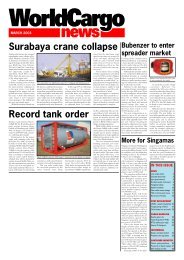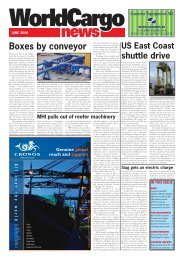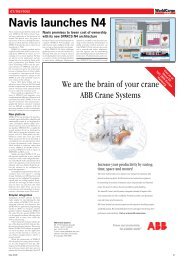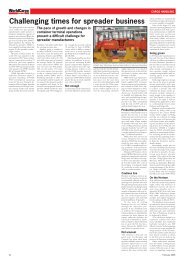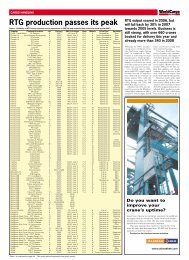Tanjung Priok super port - WorldCargo News Online
Tanjung Priok super port - WorldCargo News Online
Tanjung Priok super port - WorldCargo News Online
You also want an ePaper? Increase the reach of your titles
YUMPU automatically turns print PDFs into web optimized ePapers that Google loves.
PORT DEVELOPMENT<br />
Rijeka gears itself up<br />
The past two years have been<br />
ones of rejuvenation at Croatia’s<br />
largest <strong>port</strong>, Rijeka, and nowhere<br />
has this been better illustrated<br />
than at the <strong>port</strong>’s container terminal<br />
where more than €30M<br />
will have been spent on expansion<br />
and modernisation programmes<br />
by the end of this year.<br />
The terminal is now poised to<br />
handle a much larger share of the<br />
growing liner traffic moving in<br />
Croatia’s <strong>port</strong> of Rijeka is readying<br />
itself to handle a bigger slice of the<br />
growing liner trade between Asia<br />
and central/eastern Europe<br />
and out of the northern Adriatic<br />
Sea, especially to and from Asia,<br />
providing improvements are carried<br />
out to Croatia’s rail network,<br />
VERSTEGEN<br />
GRAB<br />
MORE<br />
MORE<br />
GRAB<br />
<br />
<br />
<br />
Super Post panamax Portainer cranes at PSA Sines, Portugal<br />
something the government has<br />
promised to do.<br />
The transformation started in<br />
April 2011 when Manila-headquartered<br />
ICTSI (51%) and Luka<br />
Rijeka, the operating arm of the<br />
Port Authority of Rijeka (49%),<br />
gained management control of<br />
Bradjica Container Terminal.<br />
The 30-year operating and investment<br />
concession commits<br />
the parties to investing €65M<br />
over this period.<br />
Immediately, ICTSI and Luka<br />
Rijeka put in place a capital expenditure<br />
programme, initially<br />
targeted at raising productivity<br />
and efficiency levels, but with the<br />
goal of expanding the terminal<br />
and gearing it up to process bigger<br />
ships. The business plan was<br />
also focused on enhancing Rijeka’s<br />
regional role for the Balkans,<br />
eastern and central Europe<br />
– a sector of the business mainly<br />
handled by Luka Koper (Slovenia)<br />
and the Italian <strong>port</strong> of Trieste.<br />
Creating a gateway<br />
Highly indicative of this whole<br />
process was the decision to rename<br />
and rebrand the facility<br />
as the Adriatic Gate Container<br />
Terminal (AGCT). “We have a<br />
dream here and that is to help<br />
develop Rijeka as the new gateway<br />
for south and central Europe,”<br />
CEO Phillip Marsham<br />
told <strong>WorldCargo</strong> <strong>News</strong>. “This is<br />
fast becoming a reality and it<br />
makes absolute sense as there is a<br />
six-day difference between calling<br />
here and calling at Benelux<br />
and/or German <strong>port</strong>s.”<br />
He was speaking after a recent<br />
reception at the terminal to<br />
commemorate the completion of<br />
328m of new quay line, with a<br />
depth alongside of 14.2m, and delivery<br />
of €24M of new handling<br />
equipment. This included the<br />
facility’s first post-panamax STS<br />
gantry cranes, featuring a 50m<br />
outreach, capable of handling<br />
ships loaded with 18 rows across<br />
the weather deck. Equipped<br />
with RAM twin-lift spreaders,<br />
AGCT’s CEO Phillip Marsham<br />
AGCT recently took delivery of €24M of new equipment including two<br />
ZPMC post-panamax STS gantry cranes and six RTGs<br />
the ZPMC cranes can lift 51t.<br />
In addition, the May delivery<br />
included two 19.5m-span RMGs<br />
for AGCT’s expanded on-dock<br />
rail yard, with each 41t-capacity<br />
gantry able to work across four<br />
loading/discharge tracks. ZPMC<br />
also delivered six RTGs, each<br />
able to span across seven container<br />
rows plus the truck lane and<br />
with a lift height of one-overfive<br />
and SWL of 41t.<br />
“This new equipment, firmly<br />
puts Rijeka on the map of<br />
the northern Adriatic region,”<br />
stressed Marsham. “We now have<br />
a couple of months in which<br />
to commission the equipment<br />
and the new terminal should<br />
be fully operational in July. This<br />
coincides with Croatia joining<br />
the European Union (EU) and<br />
that means seamless borders with<br />
our northern neighbours, which<br />
will also encourage trade. We are<br />
happy that everything is coming<br />
together. This is indeed a new<br />
chapter for the <strong>port</strong> of Rijeka.”<br />
For the remainder of the year,<br />
AGCT management will focus<br />
on expanding and improving<br />
the rail transfer facility, including<br />
laying tracks for the RMGs. The<br />
gate will also be relocated away<br />
from the city and closer to the<br />
main motorway and the inland<br />
container depot at Skrljevo.<br />
With all customs activities<br />
also due to be conducted on site,<br />
rather than split between the terminal<br />
and a location elsewhere,<br />
Marsham expects truck turnaround<br />
times to improve further<br />
and for this to be another strong<br />
selling point for AGCT.<br />
Enticing the carriers<br />
He is confident that the new<br />
deep draught berth at AGCT will<br />
provide Rijeka with much better<br />
operating flexibility and lead<br />
to some ocean carriers revamping<br />
their north Adriatic service<br />
networks by placing Rijeka as<br />
the first <strong>port</strong> of call and, consequently,<br />
discharging more cargo.<br />
He explained: “Currently<br />
Maersk Line/CMA CGM, for<br />
instance, call at Trieste and Luka<br />
Koper first because of our sea<br />
and air draught [under the crane]<br />
limitations, but then have to return<br />
to Trieste for empties. Our<br />
new terminal can change this<br />
and save them voyage time and<br />
costs.”<br />
The AGCT chief also alluded<br />
to Luka Koper’s yard and rail capacity<br />
as filling up and its operating<br />
efficiency as being in decline.<br />
It handled more than 600,000<br />
TEU in 2012.<br />
“With our new terminal and<br />
handling equipment, expanded<br />
yard, increased rail capacity and<br />
closer distance to the Hungarian<br />
border, plus Croatia’s admission<br />
to the EU, we can offer shipping<br />
lines a clear first <strong>port</strong> of call<br />
advantage and their customers<br />
faster transit times to key markets,<br />
such as Budapest. We can<br />
save the shipping lines a day on<br />
their voyages.”<br />
He also believes AGCT now<br />
has the potential to act as a subregional<br />
hub for northern Italy<br />
(Ancona-Venice) and for smaller<br />
eastern Adriatic <strong>port</strong>s in the<br />
Split-Durres (Albania) range.<br />
Critical to the success of the<br />
expanded terminal will be improvements<br />
to the nation’s rail<br />
network where capacity and average<br />
train speeds need to be improved.<br />
Already, the government<br />
has made progress with a unified<br />
power system, allowing non-stop<br />
train services to Budapest. Since<br />
November, AGCT has been dispatching<br />
regular services to Serbia<br />
and Budapest, with the latter<br />
destination reached in 48 hours.<br />
Longer-term, Marsham sees<br />
great op<strong>port</strong>unities in developing<br />
a so-called “Baltic-Adriatic<br />
freight corridor” and linking up<br />
with ICTSI’s <strong>port</strong> operations at<br />
the Baltic Container Terminal in<br />
Gdynia, Poland.<br />
Rail improvements<br />
Within the <strong>port</strong>, AGCT is set to<br />
double its intermodal rail capacity,<br />
raising the yard’s capacity to<br />
360,000 TEU a year. Four 240m<br />
tracks will be used for loading/<br />
discharge activities. Ultimately,<br />
these will be extended to 318m<br />
in length so that standard size<br />
European block trains can be run.<br />
“After this year, AGCT will<br />
move into an operational phase<br />
and upgrades at the site will then<br />
become volume related,” explained<br />
Marsham.<br />
He is confident that the declines<br />
in cargo that have taken<br />
place at AGCT in recent years – in<br />
2012 126,680TEU was handled<br />
compared with 168,779 TEU in<br />
2008 – can be stemmed. “Our<br />
projections are for box traffic to<br />
double by 2015 when we expect<br />
to be handling 245,000 TEU,”<br />
Marsham told <strong>WorldCargo</strong> <strong>News</strong>.<br />
The expansion of AGCT is<br />
just one part of the <strong>port</strong> authority’s<br />
own gateway aspirations for<br />
Rijeka. It is determined to add<br />
a second container terminal and<br />
has already secured €70M in<br />
World Bank funding to build the<br />
first 400m of a planned 680m of<br />
quay at the new facility. It will<br />
have a draught alongside of up<br />
to 20m.<br />
“We hope to have the first<br />
phase of this project completed<br />
in late 2016 or Q1 2017,” explained<br />
Vlado Mezak, director<br />
of Rijeka Port Authority. “The<br />
schedule for the remaining 280m<br />
of wharf will be determined by<br />
whether public/private or EU<br />
funding is used, but I can confirm<br />
that tender documents for<br />
the 30-year operating concession<br />
will be published by the end of<br />
this year. We anticipate that container<br />
handling operations will<br />
commence during 2018.”<br />
He rejected claims that the<br />
new terminal could lead to an<br />
oversupply of capacity in Rijeka,<br />
arguing that in five years’ time<br />
AGCT’s utilisation levels would<br />
be approaching 60% of its design<br />
throughput. “It is im<strong>port</strong>ant we<br />
act ahead of the demand curve to<br />
ensure the <strong>port</strong>’s operations are efficient,”<br />
he said. “A throughput capacity<br />
of 1.2M TEU for this <strong>port</strong>,<br />
given its potential, is not so big.”<br />
The developments at AGCT<br />
and the <strong>port</strong> of Rijeka look set<br />
to change the nature of container<br />
handling activity and liner shipping<br />
patterns in the Adriatic in<br />
the coming years. <br />
52<br />
May 2013




